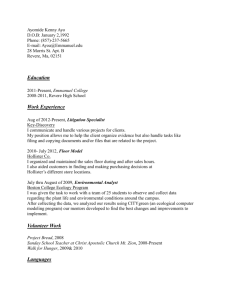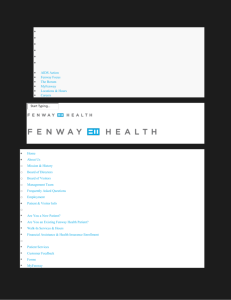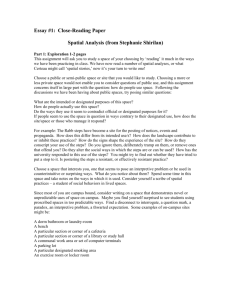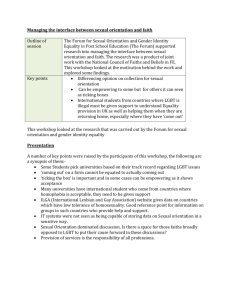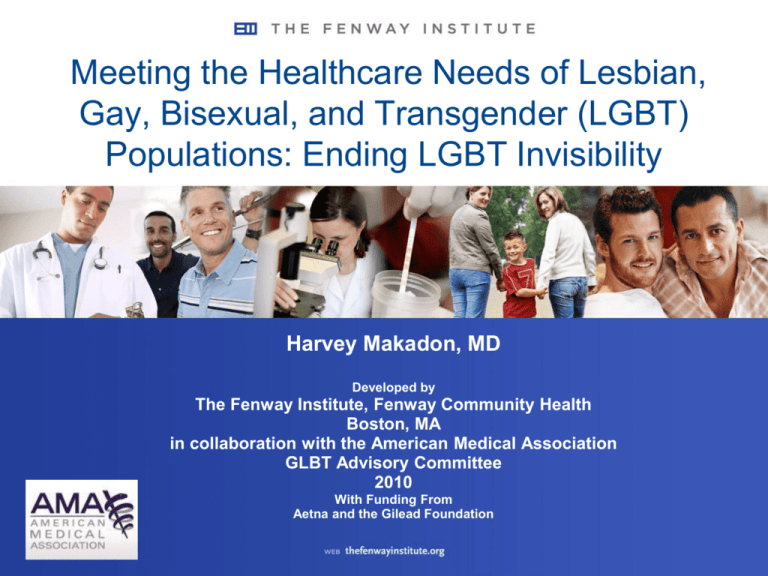
Meeting the Healthcare Needs of Lesbian,
Gay, Bisexual, and Transgender (LGBT)
Populations: Ending LGBT Invisibility
Harvey Makadon, MD
Developed by
The Fenway Institute, Fenway Community Health
Boston, MA
in collaboration with the American Medical Association
GLBT Advisory Committee
2010
With Funding From
Aetna and the Gilead Foundation
LGBT Invisibility in Healthcare
When you last saw a clinician for primary care, how many
of you were asked to discuss your sexual history? sexual
health?
Has a clinician ever asked you about your sexual
orientation?
Has a clinician ever asked if you have concerns about your
gender identity?
How many have had discussions about LGBT health issues
in school or in training? How about at CME programs?
How many feel the centers where you work actively create
a welcoming environment for LGBT staff and patients?
© The Fenway Institute, 2009
Why LGBT Health?
Two Worlds
© The Fenway Institute, 2009
Growing LGBT Acceptance
© The Fenway Institute, 2009
A Very Different Brady Bunch
© The Fenway Institute, 2009
Tyler Clementi: Suicide Following
Public Humiliation, Invasion of Privacy
© The Fenway Institute, 2009
Tyler is not alone:
Asher Brown
Billy Lucas
Seth Walsh
© The Fenway Institute, 2009
Gang Harassment of Gay Youth
in the Bronx
© The Fenway Institute, 2009
Public Discrimination and Inequality:
“I just think my children and your
children would be much better
off and much more successful
getting married and raising a
family, and I don’t want them
brainwashed into thinking that
homosexuality is an equally valid
and successful option — it isn’t,”
: “I didn’t march in …the gay
pride parade this year. My
opponent did, and that’s not the
example we should be showing
our children.”
© The Fenway Institute, 2009
What Message?
© The Fenway Institute, 2009
Stigma and Health
The publication of Erving Goffman's Stigma: Notes on the Management of
Spoiled Identity in 1963 generated a profusion of research on the nature,
sources, and consequences of stigma
Stigma …has… a dramatic and probably under-recognized effect on the
distribution of life chances such as employment opportunities, housing,
and access to medical care
The extent to which a stigmatized person is denied the good things in life
and suffers more of the bad things has been posited as a source of
chronic stress, with consequent negative effects on mental and physical
health.
Link and Phelan, Stigma and Its Public Health Implications, Lancet, Volume 367, 11 February 2006-17 February 2006,
Pages 528-529
© The Fenway Institute, 2009
The Community Responds
© The Fenway Institute, 2009
What Can We Do?
Dr. Elise D. Berlan of Nationwide Children’s Hospital in Columbus, Ohio,
and her colleagues recently found that in a study of more than 7,500
adolescents, gay males were twice as likely to report being bullied and
mostly heterosexual males were almost 1.5 times as likely to report being
bullied, as compared to straight males (J. Adolescent Health 2010; 46:
366-71). Their findings among LGBTQ young women were similar.
Dr. Berlan and colleagues advised doctors who are taking care of gay and
bisexual youth to ask about teens’ experiences with violence and bullying,
probe how they were doing with those experiences, and try to determine if
there is anything that could be done to support them
© The Fenway Institute, 2009
A Long History of Bias in Healthcare
Survey of California physicians (1982 and 1999):
1982: 39% were sometimes or often uncomfortable providing care
to gay patients (Mathews et al., 1986)
1999: 18.7% were sometimes or often uncomfortable providing care
to gay patients (Smith and Mathews, 2007)
National survey 2007 of general public:
30.4% would change providers upon finding out their provider was
gay/lesbian (Lee et al., 2008)
35% would change practices if found out that gay/lesbian providers
worked there
2005/6 surveys of medical students (AAMC reporter, 2007)
15% aware of the mistreatment of LGBT students at their schools
17% of LGBT students reported hostile environments
© The Fenway Institute, 2009
Proportion of Physicians Discussing
Topics with HIV Infected Patients
-Adherence to Therapy
84%
-Condom Use
16%
-HIV Transmission or
Risk Reduction
14%
© The Fenway Institute, 2009
Discomfort as a Barrier
“Ironically, it may require greater
intimacy to discuss sex than to
engage in it.”
The Hidden Epidemic
Institute of Medicine, 1997
© The Fenway Institute, 2009
LGBT Demographics,
Concepts, and Terminology
© The Fenway Institute, 2009
L,G,B and T
Demographics,
Concepts, and Terminology
© The Fenway Institute, 2009
“No, we are not twins.”
© The Fenway Institute, 2009
Same-Sex Couples in the United States
LGB Demographics
in the U.S.
Identify as lesbian,
gay or bisexual:
Same-Sex Households
1.4 – 4.1%
Same-sex sexual
contact in last year:
3% (women)
4% (men)
Same-sex sexual
contact ever:
4.3 -11.2% (women)
6 - 9.1% (men)
(Laumann et al.,1994; Mosher et al.,
2005)
(Makadon, 2006); Map Courtesy of
Makadon, H. J. N Engl J Med 2006;354:895-897J. Bradford PhD. and K. Barrett PhD.,
SERL, VCU
© The Fenway Institute, 2009
There is diversity of expression in our own
communities and globally
© The Fenway Institute, 2009
Understanding Sexual Orientation
Identity
Attraction
©22The Fenway Institute, 2009
Behavior
Discordance between Sexual Behavior
and Self -Reported Identity
2006 study by the NY Department of Mental Health
sample of 4193 men in NYC
9.4% of men who identified as straight had sex with a man in the prior
year
More likely to
• belong to minority racial and ethnic groups,
• be of lower socio-economic status,
• be foreign born
Less likely to have used a condom
(Pathela, 2006)
77-91% of lesbians have had at least one prior sexual experience
with men
8% in the prior year
(O’Hanlan, 1997)
© The Fenway Institute, 2009
Transgender: The T in LGBT
People who persistently identify and/or
express their gender as the opposite of
their biologic birth sex and often have
hormonal and surgical treatment
(sometimes called transsexualism)
People who define themselves as a gender outside the either/or
construct of male/female – e.g., having no gender, being androgynous,
or having elements of multiple genders (some use the term
genderqueer)
People who enjoy the outward manifestations of various gender roles
and cross dress to varying extents (some use the term crossdressers)
©24The Fenway Institute, 2009
Alternative Constructs of Gender Identity:
Terminology Follows Concept
Identity
Begins
Here
Identity
Begins
Here
Individual Construct
Gender Affirmation
© The Fenway Institute, 2009
Medical Construct
Gender
Reassignment or
Transitioning
Getting to Know Your Patients
© The Fenway Institute, 2009
How well do you know your patients?
New Patient
New Lesbian Patient
How do you feel when learning this?
© The Fenway Institute, 2009
Taking a History
The core comprehensive history for LGBT patients is the
same as for all patients (keeping in mind unique health
risks and issues of LGBT populations)
Get to know your patient as a person (e.g., partners,
spouses, children, jobs)
Avoid judgment or bias
Assure confidentiality – and ask permission to include
sexual orientation and gender identity on medical chart
The Joint Commission Roadmap/ Meaningful Use
Non Discrimination
Recording Identity
© The Fenway Institute, 2009
Communicating with Patients
Mirror the patients’ language: how do they identify their
sexual orientation and partners? Their gender?
Use gender neutral terms and pronouns when referring to
partners, unless you are sure
“Do you have a partner or spouse? Are you currently in a
relationship? What do you call your partner?”
Use the pronoun that matches the person’s gender identity
If you slip up, apologize and ask the patient what term is
preferred
© The Fenway Institute, 2009
Learning about Identity, Behavior, and
Desire through the Sexual History
Explain to patients that the sexual history is routine and
confidential:
“I am going to ask you some questions about your sexual health that I
ask all my patients. The answers to these questions are important for
me to know to help keep you healthy. Like the rest of this visit, this
information is strictly confidential.”
Ask about sexual health as well as behavior (e.g.,
satisfaction with sexual function)
Assess comfort with sexuality
“Do you have any concerns or questions about your sexuality, sexual
identity, or sexual desires?”
© The Fenway Institute, 2009
The Sexual History, cont’d
Assess sexual behavior
“Have you been sexually involved with anyone during the past year,
including oral, vaginal, anal sex, or other kinds of sexual practices?”
“Are you sexually involved with women, men, or both?” (CCAC, 2001)
“How many sexual partners have you had in the past twelve months?”
Assess risk for HIV and STIs
“How do you protect yourself from HIV and other STIs? (pregnancy)?”
If use condoms or latex dams: “How often do you use condoms or latex
dams when you have sex: all the time, most of the time, once in a
while?”
If barrier use is not consistent, ask: “When and with whom do you not
use condoms or latex dams?”
“Do you use alcohol or drugs when you have sex?” “Does your
partner(s)?”
©31The Fenway Institute, 2009
Gender Identity
Ask all patients about gender identity concerns – make it
routine:
“Because so many people are impacted by gender issues, I have
begun to ask everyone if they have any concerns about their
gender. Anything you do say about gender issues will be kept
confidential. If this topic isn’t relevant to you, tell me and I’ll move
on.” (Feldman and Goldberg, 2006)
Or ask:
“Out of respect for my clients’ right to self-identify, I ask all clients
what gender pronoun they’d prefer I use for them. What pronoun
would you like me to use for you?” (Feldman and Goldberg, 2006)
© The Fenway Institute, 2009
Understanding Desire: Support for
“Coming Out”
Can happen at any age
regarding sexual orientation or
gender identity
Ask patients who are coming
out if they have family and
community supports
Resources:
Youthresource.com
PFLAG.org
HRC.org
© The Fenway Institute, 2009
The Core of the Cross-cultural Interview
Respect
Curiosity
Empathy
Adapted from Betancourt and Green
© The Fenway Institute, 2009
Health Disparities and Specific
Concerns in LGBT Populations
© The Fenway Institute, 2009
Background: Disparities in LGBT Health
Research so far: Growing but limited number of studies;
methodological issues
Institute of Medicine Report on Lesbian Health conclusions
(1999): Enough evidence to support more research; develop
better methods of conducting that research
Healthy People 2010 goal: Eliminate health disparities that
occur due to differences in sexual orientation
Future research on range of LGBT health issues:
The Population Center at The Fenway Institute
Other institutions across the nation
The Institute of Medicine: Committee on LGBT Health
Status and Research Gaps and Opportunities
© The Fenway Institute, 2009
LGB Mental Health Concerns
As compared to self-identified heterosexuals (Cochran et al 2003):
Gay and bisexual men have
higher prevalence of:
Depression
Panic attacks
Suicidal ideation
Psychological distress
Body image/eating
disorders (Siever, 1994; Kaminski
Lesbian and bisexual women
have higher prevalence of:
Generalized anxiety disorder
Depression
Antidepressant use
Psychological distress
et al, 2005)
Screen for disorders; assess comfort with
sexual identity; social supports
© The Fenway Institute, 2009
LGB Youth (12-24 years)
Primary Health Concerns:
Smoking
Homelessness
Suicide attempts
Risk of being bullied, threatened, sexually coerced
Lack of family support
Higher levels of parental rejection associated with higher rates of
attempted suicide, drug use, depression, and unprotected sex (Ryan,
et al, 2009)
For tips, see the Family Acceptance Project website:
http://familyproject.sfsu.edu/.
© The Fenway Institute, 2009
Lesbian and Bisexual Women:
Health Concerns
Smoking
Alcohol abuse
Obesity / Excess weight
Mental health
Cardiovascular disease
Cancer prevention
Cervical; Breast
STI’s: HPV, HSV 1, BV, Trichomonas, ? HIV
Personal safety
hate crimes, sexual and domestic violence
Screen according to current guidelines
© The Fenway Institute, 2009
Gay and Bisexual Men: Health Concerns
Smoking
Recreational drug use (alcohol abuse?)
marijuana, inhalants, ketamine, GHB and cocaine
Crystal methamphetamine: growing use and concern
Use in conjunction with sex raises risk of HIV/STIs
Sexually transmitted infections (STIs) and viral hepatitis
Anal cancer
Mental health
Personal safety
hate crimes, sexual and domestic violence
Screen according to current guidelines
© The Fenway Institute, 2009
Transgender Standards of Care
Mental health evaluation
Hormone therapy
Age at start?; level of feminine/masculine?; side effects
Self Treatment
Surgery for gender affirmation
WPATH: Standards of Care
www.wpath.org
Vancouver Coastal Health (UBC)
http://www.celebratevgh.ca/transhealth/
Endocrine Society
http://www.endo-society.org/guidelines
© The Fenway Institute, 2009
© The Fenway Institute, 2009
Life Cycle: Family Matters!
Marriage / Commitment
Reproduction
Parenting
Legal Issues
© The Fenway Institute, 2009
Life Cycle: “Aging and Gay, and Facing
Prejudice in Twilight”
Isolation and fewer family
or community supports
Less likely to be “out” than
younger LGBT
Discrimination in long-term
care facilities
Need for advance
directives – death of
partner can bring great
strain and confusion
© The Fenway Institute, 2009
Jane Gross, The New York Times, October 9, 2007
Creating Change at Home:
Better Environments for Caring,
Learning, and Working
© The Fenway Institute, 2009
Assessing the Current Environment
Do you know if LGBT patients feel welcome and feel safe to
disclose their sexual behavior and identity?
Do you know if LGBT students, trainees, faculty, and staff
feel safe and accepted?
Does everyone feel comfortable being themselves?
Can everyone talk freely with colleagues?
Are students and professionals being taught about LGBT
health needs?
© The Fenway Institute, 2009
© The Fenway Institute, 2009
The Patient Environment
The Joint Commission-2010
Create intake forms that include the
full range of sexual and gender identity and expression
Ensure confidentiality on forms
Train all staff to be respectful of LGBT clients, and to use
clients’ preferred names and pronouns
Post non-discrimination policy inclusive of sexual
orientation and gender identity
Display images that reflect LGBT lives (e.g., posters with
same-sex couples, rainbow flags, trans symbol)
Provide educational brochures on LGBT health topics
Offer unisex bathrooms
© The Fenway Institute, 2009
HIV: Metaphor for LGBT Health
"This disease will be the end of many of us, but not nearly
all. And the dead will be commemorated, and will struggle
on with the living, and we are not going away. We wont die
secret deaths anymore. The world only spins forward. We
will be citizens. The time has come.“ Angels in America, Tony Kushner
© The Fenway Institute, 2009
© The Fenway Institute, 2009
Resources
AMA GLBT Advisory Committee: www.ama-assn.org
Training video on taking a sexual history
Sample non-discrimination policy
The Fenway Institute: www.lgbthealtheducation.org
LGBT Health Learning Modules
Links to many other resources for providers and consumers
Gay and Lesbian Medical Association: www.glma.org
Pamphlet with guidelines for providers on LGBT health
The Fenway Guide to Lesbian, Gay, Bisexual, and
Transgender Health. American College of Physicians, 2008.
(order from Amazon.com or acponline.com)
© The Fenway Institute, 2009
Enhancing Healthcare=Enhancing Human Rights
© The Fenway Institute, 2009
STI Screening in MSM (CDC)
Sexually active MSM should be tested for STIs annually
Or every 3-6 months if have multiple or anonymous partners, use
illicit drugs in conjunction with sex, or use methamphetamine:
HIV (serology)
Syphilis (serology)
Urethral gonorrhea (culture or NAAT*) and Chlamydia
(NAAT) if had insertive intercourse in past year;
Rectal gonorrhea and Chlamydia (culture) if had receptive
anal intercourse in past year;
Pharyngeal gonorrhea (culture) if had receptive oral
intercourse in past year
*nucleic acid amplification test
© The Fenway Institute, 2009
STI Screening in MSM (CDC),
cont’d.
Vaccinate against hepatitis A and B (unless previous
infection or immunization is documented)
Consider HSV-2 testing (type-specific serology) if infection
status is unknown
Anal Pap not yet recommended by CDC (but some experts
do recommend it)
HPV vaccine in men being evaluated
© The Fenway Institute, 2009
Safer Sex Counseling Guidance
Behavioral risk /harm reduction approaches:
Abstinence
Monogamy with uninfected partner
Reduce number of partners
Low-risk sexual practices
Consistent and correct use of barrier methods
Cease engaging in one form of high-risk activity
Avoid excessive substance use
Advise having a proactive plan to protect self and partners
Counsel on correct use of barrier protection
Educate on availability of post-exposure prophylaxis (PEP)
for high-risk HIV exposure (e.g. condom break, post-coital
HIV disclosure)
© The Fenway Institute, 2009
Anal Cell Carcinoma: Screening
No consensus on whether to screen
No randomized trials; no formal guidelines except NY State AIDS
Institute (www.guideline.gov)
Rationale for screening:
Rates in MSM similar to CSCC in women before routine Pap
Hypothesis that pathogenesis is same as cervical cancer
Effective screening modalities
Morbidity and mortality related to anal cancer
Cost effectiveness
(Kreuter and Wieland, 2009; Palefsky, 2009; Goldie et al., 2000; Volberding,
2000)
© The Fenway Institute, 2009
Whom and How to Screen
Whom to screen?
HIV infected men and women (yearly)
MSM with high-risk behavior
Transplant recipients
Women with cervical cancer, high grade lesions
Need larger studies for definitive guidance
How to screen?
Anal Pap
Follow Up High Resolution Anoscopy (HRA)
Digital Rectal Examination
(Ryan et al., 2000; Goldie et al., 2000; Palefsky J et al. 2008, Palefsky 2008;
Kreuter and Wieland, 2009)
© The Fenway Institute, 2009


